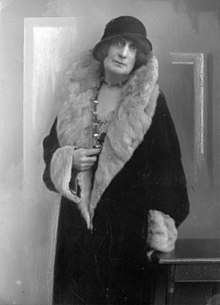Noëlle Roger
Noëlle Roger, the pen name of Hélène Pittard (September 25, 1874 – October 5, 1953), was a Swiss author writing in French.
Hélène Pittard | |
|---|---|
 | |
| Born | Hélène Dufour September 25, 1874 Geneva, Switzerland |
| Died | October 5, 1953 (aged 79) Geneva, Switzerland |
| Pen name | Noëlle Roger |
| Nationality | Switzerland |
| Genre | novel, play, short story, science fiction |
Biography
The daughter of Théophile Dufour, a Swiss jurist, and Léonie Bordier, she was born Hélène Dufour in Geneva. Her maternal grandfather was Henri Bordier, a French historian. In her youth, she showed talent for both poetry and painting, eventually choosing to focus on writing.[1]
Her first novel Larmes d'enfant was published in 1896. Her pen name was derived from the two names of brothers: reversing Léon gave Noëlle and Roger was used as is. She apprenticed as a journalist in London. Then, in 1900, she married the anthropologist Eugène Pittard. Her travels with her husband to various places inspired:
- La Route de l'Orient (1914)
- Princesse de Lune, a novel (1929)
- En Asie Mineure (1930)[1]
During World War I, she trained as a nurse and looked after wounded French soldiers at a hospital in Lyon. She published some novels inspired by her experiences during the war and then produced a number of works of speculative fiction including:
- Le nouveau Déluge (1922)
- Le nouvel Adam (1924), translated into English as The New Adam (1926)[2]
- Celui qui voit (1926)
- Le soleil enseveli (1928)
- Le nouveau Lazare (1935)
She also produced biographies of Jean-Jacques Rousseau, Germaine de Staël and Henry Dunant, as well as plays for the theatre and for radio.[1]
Works for children included:
- L'Enfant cet inconnu (1941)
- Peau d'éléphant (1943)[1]
In 1948, she received a medal from the Académie française for her work.[1]
She died in Geneva at the age of 78.[1]
References
| Wikimedia Commons has media related to Noëlle Roger. |
- "Papiers Noëlle Roger" (PDF) (in French). Bibliothèque de Genève.
- Bleiler, Everett Franklin (1990). Science-fiction, the Early Years: A Full Description of More Than 3,000 Science-fiction Stories from Earliest Times to the Appearance of the Genre Magazines in 1930 : with Author, Title, and Motif Indexes. Kent State University Press. p. 635. ISBN 0873384164.